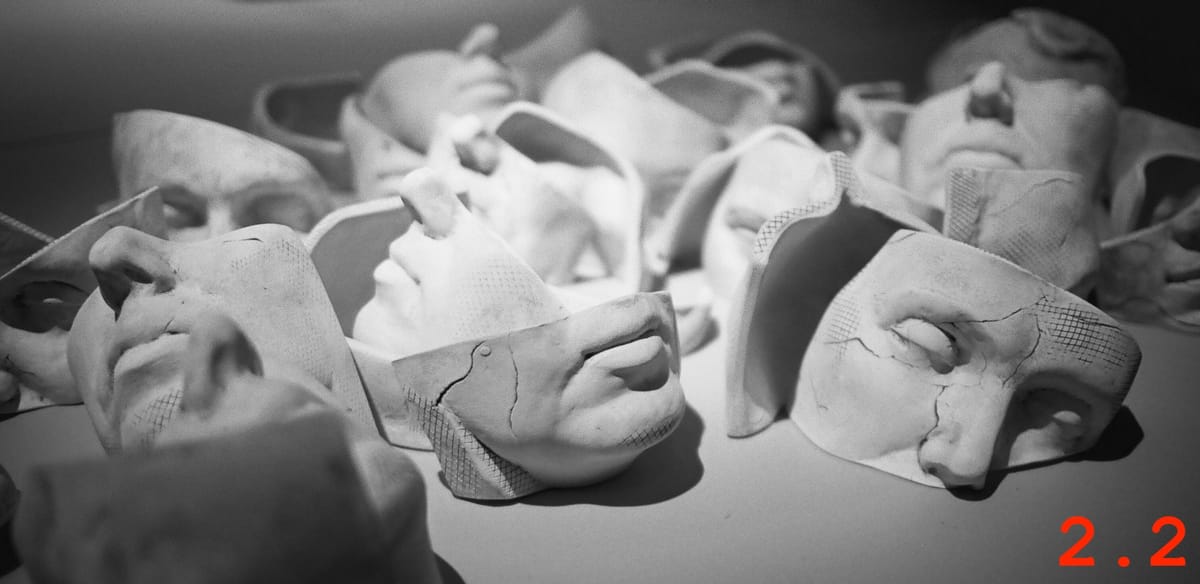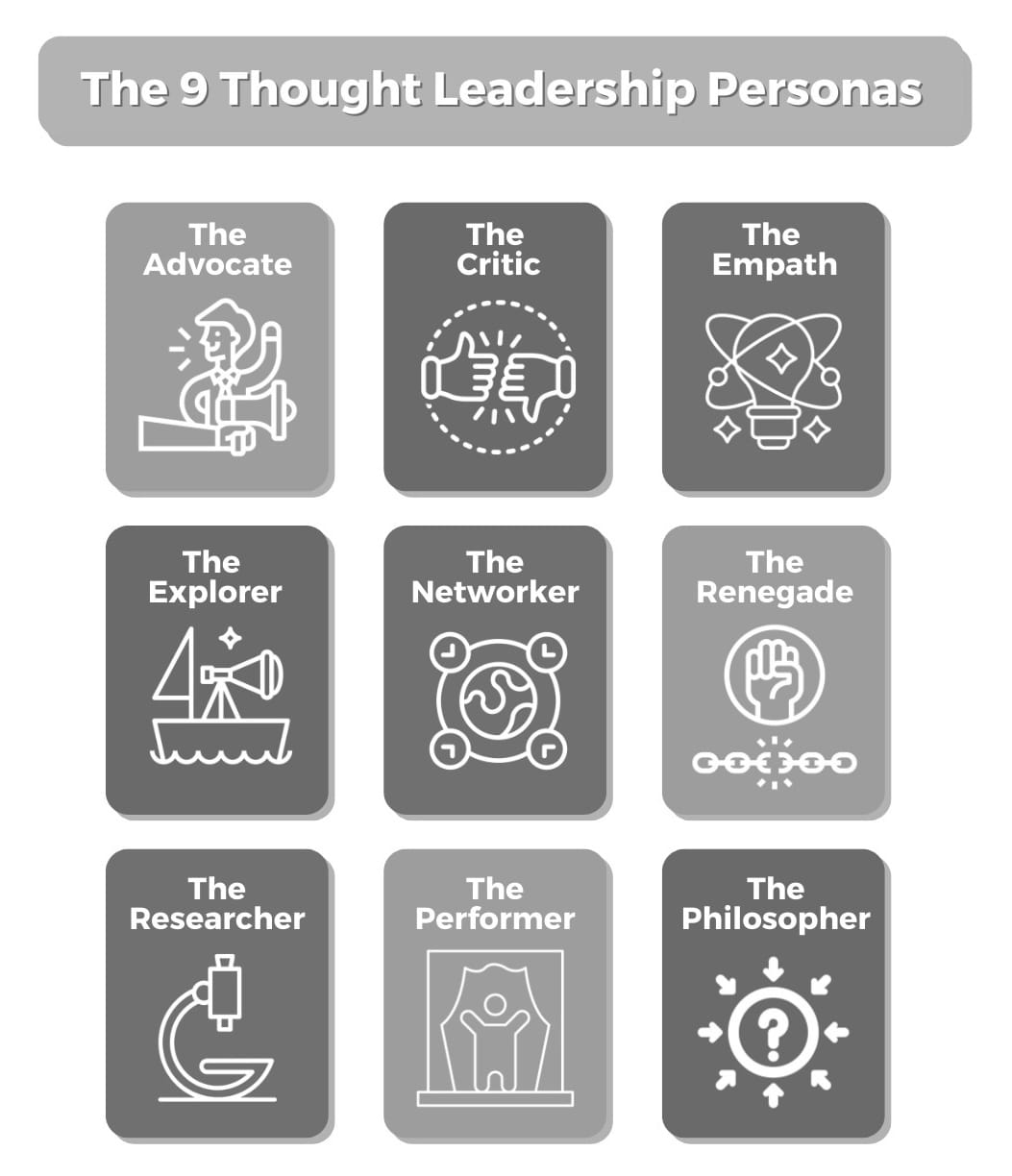What's Your Thought Leader Persona?

Who are you as a thought leader? There are many ways to take a stance on a particular topic. Choosing a persona can be a useful technique for creating consistency. Adopting specific personas can shape both individual pieces of thought leadership and their overarching brand.
The What and Why of Personas
Think of it this way. The traits of thought leadership personas give you a framework for how you approach your topic and communicate in your thought leadership output. Understanding the best persona for a particular topic and context makes your approach resonate more effectively.
You can also use multiple personas for various contexts, just like you do in real life.
- As a thought leader, adopting a persona helps you deliver the right messages for a format or situation. For example, you might find yourself using one persona in an opinion piece, another in a blog, a third in a whitepaper, and still a fourth in a live event.
- As a thought leadership champion, you can use personas as a tool to build up an overarching brand voice and provide coaching input to individual leaders in your organization.
- As a brand strategist, you can find ways to reinforce your brand attributes with personas that fit your messaging and brand story. Companies can have personas, too.
From Persona to Personality
Over time, your work will help crystalize your reputation as a particular persona or hybrid.
- It becomes what people expect to see and hear from you when they read your next article or listen to your next podcast.
- It’s one of many elements that sets you apart (voice, point of view, and persona).
- It contributes to building a brand that reflects your deeper personality and the way you choose to show up,
Nine Possible Archetypes
Using archetypes can help you develop a specific persona. Archetypes are figures that reflect patterns in human nature. They reflect who we are and how we behave in certain scenarios. Recognizable archetypes include the Hero, the Sage, and the Shadow. In Jungian psychology, these archetypes, or personas, help reveal motivations, fears, challenges, and growth opportunities in life.
In thought leadership, the following nine archetypal personas help reveal the journey you want to take (i.e., how you plan to approach a topic and how you plan to lead your audience through it). Each one illustrates essential aspects of much more complex principles.

Note: These personas are neither good nor bad; none is preferable to the others. In alphabetical order, they are:
The Advocate: The Advocate believes passionately in a particular point of view and a vision for making something better. The desire to convince and instill belief inspires the Advocate’s motivations, with a desire to spur people to greater efficiency, effectiveness, decency, and more.
The Critic: The Critic evaluates situations against their standards of good and bad. Sometimes, the criteria are objective and sometimes subjective. Critics can be especially incisive in how they analyze their topic and current trends, giving people the tools to think critically about situations they previously took at face value.
The Empath: The Empath understands people’s pain points, offering innovative thinking and insights as a way to alleviate or remove them. This orientation to understanding and positive impact fuels the Empath’s thinking.
The Explorer: The Explorer pushes out into unfamiliar territory, willing to explore new ideas, technologies, and solutions that haven’t yet worked their way into conventional wisdom. Passion for what’s new and for sharing knowledge about it tends to give the Explorer an edge.
The Networker: The Networker brings together thought leaders who explore different facets of a particular area. Bringing together operational, technical, strategic, and other perspectives — often in live formats such as panels or interviews — expands the Networker’s impact on their audience and area of expertise.
The Renegade: The Renegade doesn’t mind breaking things or stepping on a few toes to put forward a radical, counterintuitive point of view. The goal is to challenge conventional wisdom and open up new lines of thinking. Constructive challenge to the status quo propels The Renegade’s thinking forward.
The Researcher: The Researcher builds and shares a comprehensive, pragmatic point of view on topics or trends. Thought leadership from a Researcher often includes historical roots, data, and descriptions of future scenarios or outlooks. Their output is anchored on concrete facts that add value to the way people understand the subject matter.
The Performer: The Performer is a star of stage and screen. This thought leadership persona thrives and shines in front of an audience, especially in formats such as videos, podcasts, webinars, and presentations. Don’t confuse the flair with superficiality, however. The art of captivating an audience simply helps the Performer convey thought leadership in compelling ways.
The Philosopher: The Philosopher asks why, why, and why again, in a disciplined, logical, and structured manner. Sometimes, this persona seems theoretical or metaphysical. Still, when an audience thinks through how the Philosopher’s thought leadership applies to their own needs and context, they come away with big ideas, transformed insights, and new options.
Questions to Ask About Your Persona
- Which of these personas sound most like you?
- When do you tend to play these roles?
- How can you use them to strengthen your delivery?
- When reviewing a draft of thought leadership content, is there a distinct persona?
- What could you adjust in your tone and approach to create a more consistent persona?
Three Grace Notes
"Archetypal ideas are part of the indestructible foundations of the human mind. However long they are forgotten and buried, always they return, sometimes in the strangest guise, with a personal twist to them or intellectually distorted, but continually reproducing themselves in new forms representing the timeless truths that are innate in human nature." — Carl Jung, Psychology and Religion: West and East
"Wonder is the state of being open to the world, its beauty, and potential possibilities. With wonder, the need to cope becomes less important and the discomfort on the current path becomes more noticeable." — Paul Millerd, The Pathless Path: Imagining a New Story For Work and Life
"Just try to get to know what you live with inside by externalizing the voice. Give it a body and put it out there in the world just like everybody else. Let it be a person who says on the outside exactly what the voice of your mind says inside." Michael Singer, The Untethered Soul: The Journey Beyond Yourself
Note: The links above are affiliate links. I'm using them in lieu of paid subscription tiers or digital tip jars. Seems like a much more graceful way to generate financial support while sharing more thinking and writing that can guide thought leadership.
